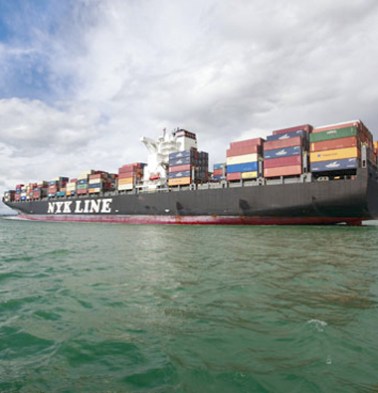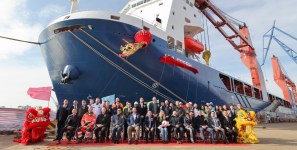ORIENT EXPRESS
HOW THE G6 ALLIANCE OF OCEAN CARRIERS IS SAVING SHIPPERS TIME AND MONEY
Shipping to Asia is getting faster and easier thanks to the formation of the G6 Alliance, a cooperation of two existing partnerships of ocean liners—the Grand Alliance (Hapag Lloyd, NYK Line, Orient Overseas Container Line) and the New World Alliance (APL, Hyundai Merchant Marine and Mitsui O.S.K. Lines, better known as MOL). With their coordination, a cargo vessel departing Savannah, for instance, can reach Thailand a full three days earlier than in previous years; a U.S. shipper exporting its goods to Hong Kong now has the option to leverage transport through the Suez Canal from multiple domestic ports at a slightly lower cost than in the past.
The G6 was established in December 2011 and commenced operations in March 2012, creating one of the largest vessel networks in the Asia-to-Europe trade lane. Under the expansion umbrella, the Alliance operates six Asia-to-North America East Coast service loops, one of which is new and the others a result of a merger and revision of services originally offered by the Grand Alliance (GA) and New World Alliance (NWA). Operation of the loops involves the deployment of more than 50 vessels with capacities ranging from 4,500 to 8,000 20-foot-equivalent units (TEUs) to connect some 30 ports in Asia, the U.S. and Canada, Central America, the Caribbean, the Indian subcontinent, the Mediterranean and the Middle East. Three of the services transit the Suez Canal and three others transit the Panama Canal.
“The move into this trade was a necessary one given the growth of the Southeast Asian market and the added capacity necessary to serve the Pacific Rim,” says Lamont Petersen, vice president, Marketing, Hyundai Merchant Marine.
Petersen and representatives of other G6 members say exporters and importers have begun to enjoy broader port coverage and increased sailing frequencies as a result of the Alliance’s inception and recent expansion. The advent of the G6 has boosted the number of port pairs served—calculated based on counting each individual origin/destination set once, regardless of how many times per week ships call them—according to Tim Walsh, vice president of Marketing for NYK Line (North America). Specifically, Walsh says, G6 serves 38 percent and 26 percent more port pairs than the GA and NWA, respectively. It also dramatically increases the number of port pair connections offered—calculated by counting the total number of times per week ships call each set of origins and destinations—compared to GA (up 65 percent) and NWA (up 26 percent). Market coverage of Asia and beyond has expanded too, with NWA adding Halifax, Cagliari, Laem Chabang, Qingdao and Shekou, and GA adding Jacksonville, Algeciras, Damietta and Jebel Ali (U.S. outbound).
“Many of the critical Asian ports have multiple calls per week now with G6, such as those in Central and South China and key ports used extensively for transshipment,” like Busan and Singapore, Walsh explains. “Singapore, in particular, has three weekly calls to ensure smooth connections to the extensive feeder networks running to/from the trunk vessel strings.”
COMPETITIVE TRANSIT TIMES
The expansion in service has also wrought more competitive transit times for shipments to ports throughout Asia, Alliance members claim. For example, according to information provided to Global Trade by Hapag-Lloyd, cargo bound for Vietnam from Savannah now reaches its destination in 34 days, versus 39 days prior to the introduction of the new service.
“The transit times are highly competitive, as this feature is one of the primary objectives of the G6 Alliance,” says Timothy A. Pajak, corporate communications specialist for MOL. “The vast majority of shippers care primarily about reliability rather than simply transit times.”
Transit time from Savannah to Thailand has been shortened from 39 days to 36 days. The carrier cites similar improvements on transit times for import cargo. Notably, in the case of Savannah, cargo shipped from Xiamen arrives in 31 days as opposed to 39 days; cargo shipped from Hong Kong takes just 28 days versus 34 days; cargo shipped from Shanghai arrives in 28 days versus 30 days; and cargo shipped from Ningbo saves four days, reduced to 28 days from 32.
“While much of the service rotations have gone through significant changes, the G6 transit times will continue to be very competitive, as they were with the GA and NWA,” Walsh says. “Preserving some of the ‘best of both’ was an important consideration.”
However, Walsh adds that the Alliance, in configuring the new service, placed considerable emphasis on reliability. Accordingly, “adequate time” has been built into service schedules to allow for realistic transit times and a higher on-time percentage.
“Overall, we believe many of those on-time benefits found in the Asia-Europe G6 launch will be found in this iteration as well,” Walsh states.
MOL’s Pajak agrees reliability is the Alliance’s chief concern. “While we also take into consideration cost effectiveness, reliability, safety and our contribution to protect and promote the environment,” he says, “the most important feature of our services is reliability.”
That promise of increased cost efficiencies is coupled with more efficient container ships. The majority of the total G6 TEU capacity (approximately 61 percent) transits the Suez Canal rather than the Panama Canal (39 percent). “The closer proximity of the Suez Canal makes the cost of transit through it a less expensive proposition than the cost of transit through the Panama Canal,” Petersen says.
By contrast, division of transit between the Suez Canal and the Panama Canal under the GA and NWA umbrellas was more even, at roughly 50 percent apiece for the two consortia combined. The G6 split allows for the use of larger vessels, thereby creating economies of scale.
“By using the Suez, G6 was able to deploy post-Panamax ships into the U.S. East Coast trade earlier than the soon-to-be-completed Panama Canal expansion project,” Walsh says. “We are able to deploy up to 8,000 TEU vessels on some strings. Overall, there are fewer vessels, but still with a minor gain in capacity.”
Shippers’ reaction to the service has been very positive to date, with few complaints. The only challenge so far, Petersen reports, has been a computer glitch at Maher Terminals in New York City. Maher’s installation of a new computer system, and subsequent problems with it, led to minor shipping delays from New York and other domestic ports.
“It really was not a major deal at all, and the advantages here should far outweigh any little inconveniences going forward,” Petersen concludes.





Leave a Reply